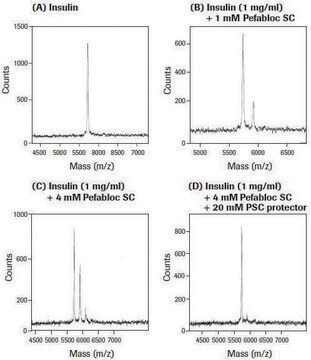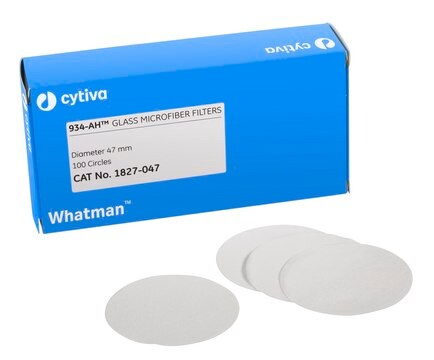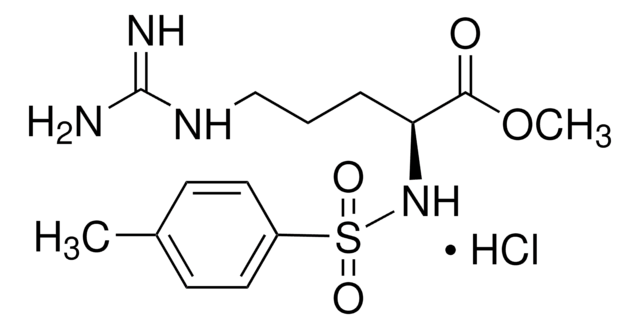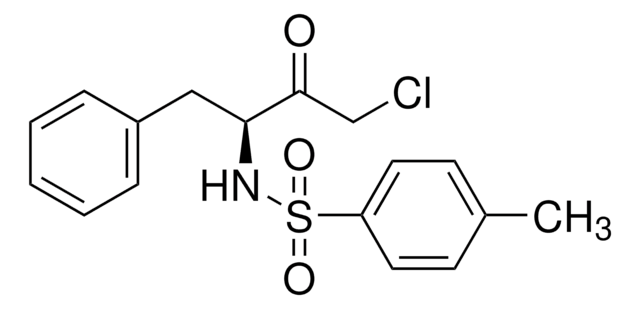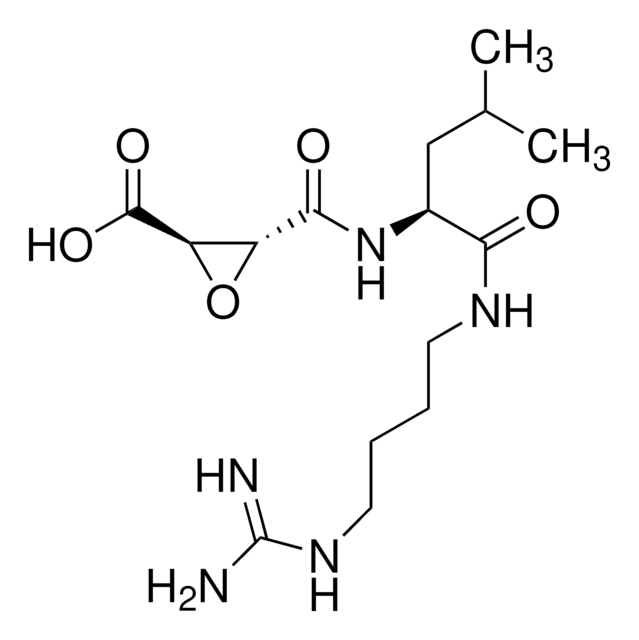11873601001
Roche
Pefabloc® SC PLUS
crystalline, suitable for blocking, suitable for protein purification, 0.1-1.0 mg/mL
Synonyme(s) :
pefabloc, serine protease inhibitor
About This Item
Produits recommandés
Forme
crystalline
Niveau de qualité
Poids mol.
239.5
Conditionnement
pkg of 5 mL (100 mg)
Fabricant/nom de marque
Roche
Concentration
0.1-1.0 mg/mL
Technique(s)
blocking: suitable
protein purification: suitable
pH optimal
neutral
Pf
175-185 °C
Solubilité
soluble (Solubility and stability of the protease inhibitor remains unchanged.)
Température de stockage
2-8°C
Description générale
Recent findings indicate that sulfonyl-type serine protease inhibitors such as Pefabloc SC and PMSF can bind covalently to proteins. This can occur when the inhibitors are used in high concentrations, or during extended incubation times under alkaline conditions. This interaction adversely affects the tyrosine and lysine residues of a protein, as well as the free amino terminus. The PLUS additive (PSC-Protector) included with this set prevents covalent attachment of Pefabloc SC to proteins when used in higher concentrations and extended incubation times at an alkaline pH.
Spécificité
Application
- Pefabloc® SC is used to inhibit the detrimental effects of proteases during preparative protein purification. The PSC-protector solution prevents nonspecific covalent modification of proteins when Pefabloc is used in higher concentrations and extended incubation times at an alkaline pH (tested by mass spectrometry).
- Due to its low toxicity toward eukaryotic cells, it may be applied in the production of recombinant proteins, during fermentation of transformed cells, where proteolytic digestion may decrease the yield of the desired product.
- Pefabloc SC is used to completely inactivate proteinase K during the preparation of chromosomal DNA in agarose plugs. For this purpose, the cells are embedded in agarose and digested with proteinase K to degrade all proteins. Before a specific restriction endonuclease is added, the proteinase K is inactivated by incubating the agarose plugs in 1 – 5 mM Pefabloc SC in 10 mM Tris-HCl, 1 mM EDTA , pH 7 for 2 hours at +37 °C or overnight.
- In contrast to PMSF, Pefabloc SC is an excellent blocker of thrombin activity in serum or plasma. In these biological fluids, PMSF interacts in a reversible manner with albumin, which reduces its free concentration and leads to a delay in thrombin inactivation. Pefabloc SC, however, does not react with serum albumin, and exhibits a threefold higher capacity to inactivate thrombin under similar conditions.
- Pefabloc SC can be used on living cells.
Caractéristiques et avantages
- Take advantage of a simplified two-reagent system. Use the PSC-Protector solution to prevent covalent binding between proteins and Pefabloc SC, even at high concentrations, extended incubation times, and at alkaline pH.
- Benefit from an easy-to-use inhibitor. Add water-soluble Pefabloc SC directly to aqueous buffers.
- Avoid hazardous compounds. Obtain non-toxic protease inhibition without risk to you, or those around you.
- Ensure protection with improved stability. Achieve consistent protease inhibition even at pH levels above 7.0 and temperatures above +4°C.
- Maximize inhibition. Be certain that your levels of active inhibitor are high enough by using a product that is reliably soluble and stable.
Conditionnement
Notes préparatoires
Pefabloc SC plus the corresponding amount of PSC-protector
Working solution: Recommended solvent is distilled water or aqueous buffer (for Pefabloc SC).
The solubility is up to 0.1 M for Pefabloc SC.
Storage conditions (working solution): -15 to -25 °C (stock solution)
Solubility and stability of the protease inhibitor remains unchanged. See Pefabloc SC.
Reconstitution
Autres remarques
Informations légales
Composants de kit seuls
- Pefabloc SC, 100 mg
- PSC-Protector solution, 5 mL ready-to-use
Mention d'avertissement
Danger
Mentions de danger
Classification des risques
Eye Dam. 1 - Flam. Liq. 3 - Skin Corr. 1B
Code de la classe de stockage
3 - Flammable liquids
Classe de danger pour l'eau (WGK)
WGK 1
Certificats d'analyse (COA)
Recherchez un Certificats d'analyse (COA) en saisissant le numéro de lot du produit. Les numéros de lot figurent sur l'étiquette du produit après les mots "Lot" ou "Batch".
Déjà en possession de ce produit ?
Retrouvez la documentation relative aux produits que vous avez récemment achetés dans la Bibliothèque de documents.
Les clients ont également consulté
Notre équipe de scientifiques dispose d'une expérience dans tous les secteurs de la recherche, notamment en sciences de la vie, science des matériaux, synthèse chimique, chromatographie, analyse et dans de nombreux autres domaines..
Contacter notre Service technique

